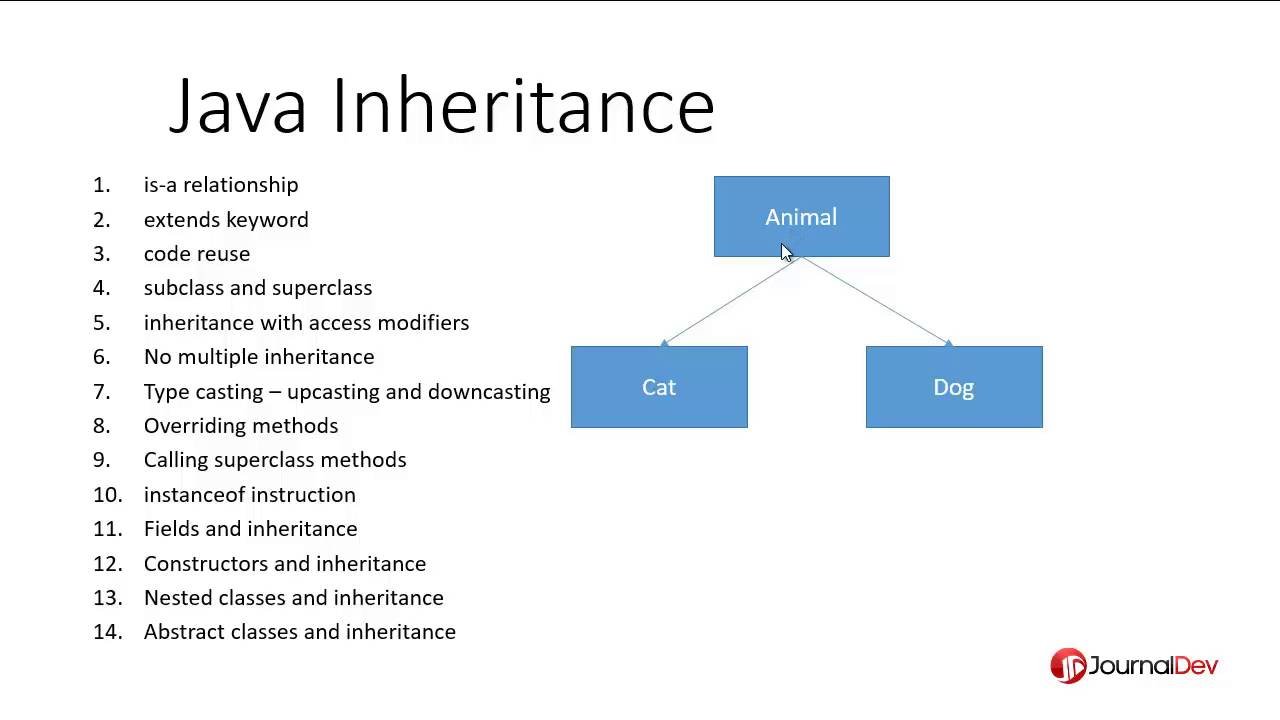Introduction: Why this guide matters
Inheritance is one of the big ideas in Java. It helps you reuse code and build clearer programs. This guide will walk you through a clear java inheritance example. You will see simple rules, short code pieces, and real tips you can use right away. I wrote this to be easy to read. Sentences are short. Words are simple. Each step shows why inheritance helps. You will learn what inheritance means. You will learn how to use extends, super, and method overriding. You will also get a fuller java inheritance example later that ties ideas together. By the end, you will feel confident to use inheritance in your programs. If something feels cloudy, return to the example and try the code. Practice makes it stick.
What is inheritance in Java?
Inheritance is a way to make a new class from an old class. The new class gets features from the old one. The old class is the superclass. The new class is the subclass. In Java, you write class Dog extends Animal to make Dog inherit from Animal. Inheritance shows an IS-A relationship. Dog IS-A Animal. Inheritance lets you reuse fields and methods. This cuts copy-paste work. It also makes code easier to read. When you see a subclass, you can expect some shared behavior. Inheritance plays well with other OOP ideas like encapsulation and polymorphism. If you need a quick java inheritance example, think of a Vehicle and a Car. Car can share code with Vehicle and add its own parts.
Why use inheritance? Simple benefits
Inheritance saves time. It reduces repeated code. If many classes share a method, put that method in a parent class. Subclasses will then inherit it. This makes updates easier. Fix code in one place. All subclasses benefit. Inheritance also helps express real-world relations. It maps code to clear ideas. Developers and future readers can understand code fast. Inheritance pairs well with polymorphism to let objects act like their parent types. That makes APIs simple and flexible. However, inheritance is not always the best tool. Sometimes composition or interfaces are better. Still, a solid java inheritance example shows how code can be cleaner and easier to maintain. Use inheritance when classes truly share behavior or identity.
Types of inheritance used in Java
Java supports several inheritance styles. The most common are single, multilevel, and hierarchical inheritance. Single inheritance means one subclass extends one superclass. Multilevel means a chain of inheritance, like A -> B -> C. Hierarchical means one superclass has many subclasses. Java does not allow multiple class inheritance. That keeps things simpler and safer. You can simulate multiple inheritance with interfaces. When learning, focus on single and multilevel types first. These styles show how code flows from parent to child. A clear java inheritance example will show single and multilevel inheritance in plain code. Once you know that, interfaces and abstract classes can expand your toolkit.
Key terms: class, subclass, superclass, extends
A class is a template for objects. A superclass is the parent class. A subclass is the child class. The extends keyword links a subclass to a superclass. The super keyword refers to the parent object. A constructor builds objects and can call super() to run the parent setup. Method overriding happens when a subclass gives a new body to an inherited method. Method overloading is different. It means multiple methods share the same name but have different parameters. These terms appear often in examples and docs. A simple java inheritance example uses these words. Keep them in mind as you read code and write your own classes.
Simple java inheritance example — step by step
Here is a tiny java inheritance example you can type and run. Imagine a Vehicle parent and a Car child. Vehicle has speed and a move() method. Car extends Vehicle and adds model. When you create a Car, it can call move() from Vehicle. You can also add honk() in Car. This shows reuse and extension. In plain code, you might write class Vehicle { void move() { System.out.println("Moving"); } } and class Car extends Vehicle { void honk() { System.out.println("Honk"); } }. Then new Car().move(); calls the inherited method. This short java inheritance example shows the heart of inheritance in a few lines.
Using super and constructors the right way
When a subclass builds, it can call the parent constructor with super(). This runs parent setup code before child setup. Use super to access parent fields or methods that a child hides. For example, a parent may set a name field. The child can call super(name) to pass that value up. Also super.methodName() can run the parent version of a method that the child overrides. Use super sparingly and clearly. Too much super calls often mean the class design needs a rethink. The best java inheritance example shows super() only when the parent has important setup to do. Keep constructors short and focused. That helps code stay readable and easy to test.
Method overriding and polymorphism explained
Method overriding lets subclasses change parent behavior. If Animal has sound(), Dog can override it with its own sound() body. Polymorphism means a parent type can reference a child object. For example, Animal a = new Dog(); then a.sound() calls Dog’s override. This lets you write code that works with parent types but runs child behavior. Polymorphism reduces if checks and makes code more flexible. It also helps when you add new subclasses later. Your existing code still works. A clear java inheritance example will show this: call a method on a parent reference and see the child version run. That is a key power of inheritance and polymorphism.
When not to use inheritance — prefer composition sometimes
Inheritance is powerful, but not always right. If classes only share some behavior, composition can be better. Composition means a class has a field that handles behavior. For example, a Printer class might hold a Scanner object. This avoids tight coupling between parent and child. Composition gives more control at runtime. It also avoids brittle parent-child chains that become hard to change. A common rule: use inheritance for IS-A relationships. Use composition for HAS-A relationships. A good java inheritance example will show where inheritance helps and where it hurts. If you find yourself forcing an IS-A link, step back and try composition instead.
Common mistakes and how to avoid them
Beginners often overuse inheritance. They put everything in a parent class and make deep chains. That leads to confusing code. Other mistakes include relying on parent fields that are not meant to be public. Also, making fields public breaks encapsulation. Use private fields and protected only when needed. Avoid repeating logic in both parent and child. Prefer super for one clear call rather than many small calls. Test your design with small examples. If a change in a parent forces many child changes, your design may be wrong. A clear java inheritance example helps spot these problems. Keep classes small, focused, and easy to read.
Advanced concepts: abstract classes and interfaces
Abstract classes and interfaces add flexibility to inheritance. An abstract class can have common code and abstract methods. Subclasses must implement those abstract methods. Interfaces declare methods a class must implement. Since Java 8, interfaces can also hold default methods. Use abstract classes when you want shared code plus required methods. Use interfaces when you want a loose contract that many classes can implement. You can implement many interfaces but extend only one class. That is how Java avoids multiple inheritance of classes. In advanced java inheritance example setups, interfaces let you mix behaviors across unrelated class trees.
Best practices and tips for design
Keep inheritance shallow. Favor composition over deep chains. Make fields private and expose behavior with methods. Use final for classes or methods only when needed. Document the parent class well. Explain which parts are safe to override. Use unit tests to lock expected behaviors. When you override, call @Override to catch mistakes. Prefer meaningful names and keep methods short. Think of inheritance as a tool to model real world relations. If a child does not truly fit the parent type, do not use inheritance. A strong java inheritance example in a project will be simple, predictable, and well tested.
A larger java inheritance example — complete walkthrough
Now let’s walk through a fuller java inheritance example that ties pieces together. Imagine a Vehicle parent with speed, fuel, and start() method. Car extends Vehicle and adds gear and openTrunk() method. Truck extends Vehicle and adds loadCapacity. Use constructors: Vehicle(int speed) then Car(int speed, String model) calls super(speed). Override toString() in child classes to show details. Use Vehicle v = new Car(60, "Sedan"); v.start(); to see polymorphism. Add an interface Insurable with getPremium() and let Car and Truck implement it. This java inheritance example shows constructors, super, overriding, and interfaces in one scene. Try this in your IDE to see how the pieces work together.
Testing and debugging inheritance code
Testing inheritance code helps catch hidden bugs. Create tests for parent methods and child overrides. Use unit tests to assert behavior rather than implementation. For example, test that move() changes position. Test Car only for added behaviors. Mock heavy dependencies to keep tests fast. Debug by checking which method runs with a parent reference. Use logging to show runtime types. If behavior is not as expected, inspect constructors and super() calls. Watch for NullPointerException from uninitialized parent fields. A good java inheritance example includes a test file. Tests not only catch bugs but also document how your classes should behave.
Real-world analogy to make it stick
Think of inheritance like a family recipe book. The family book has basic recipes. Each child gets a copy and adds a twist. The main recipe is the superclass. The child recipe is the subclass. If the family changes the base recipe, all kids who rely on it will get the new version. If one child wants a special spice, they add it in their copy. This analogy is like a java inheritance example. It shows reuse and variation. It also shows the danger: if the base recipe changes in a bad way, many kids will be affected. That is why careful design matters.
Frequently Asked Questions (FAQs)
FAQ 1 — What is the simplest java inheritance example I can run?
A tiny example uses two classes. Vehicle is the parent. Car is the child. Vehicle has void move(). Car extends Vehicle and adds void honk(). Create new Car().move() to call the inherited method. This short demo shows the main idea quickly. Add System.out.println lines to see which method runs. That helps beginners see how inheritance works in action. Try it in any Java IDE or a simple text file with javac and java.
FAQ 2 — Can I inherit from more than one class in Java?
No. Java does not allow multiple class inheritance. A class may extend only one superclass. This avoids conflicts where two parents have the same method or field. To get multiple behaviors, use interfaces. Since Java 8, interfaces can also have default methods. You can implement many interfaces and still extend a single class. This gives a balanced way to share behavior without the complexity of multiple inheritance.
FAQ 3 — What’s the difference between extends and implements?
extends links a class to a superclass or an interface to another interface. implements means a class agrees to follow an interface contract. Use extends for class-to-class or interface-to-interface extension. Use implements for class-to-interface adoption. If you need shared code, choose an abstract class to extend. If you need a contract across unrelated classes, choose an interface to implement. Both are common in real code and in java inheritance example patterns.
FAQ 4 — When should I use protected fields?
protected allows subclasses and classes in the same package to access a field. Use it sparingly. Prefer private and give access via methods. protected leaks details of implementation. If a subclass must access internal state, consider providing a protected getter instead. That keeps control and allows future changes without breaking subclasses. Most designs stay safer with private fields and public or protected methods.
FAQ 5 — How does method overriding affect performance?
Method overriding has very small overhead at runtime. Modern JVMs optimize dynamic dispatch heavily. In most apps, the cost is negligible. Focus on clear design rather than micro-optimizing overrides. If you must optimize, profile your code first. In many java inheritance example cases, readability and correct behavior beat tiny performance gains. Keep methods small and test performance only when you see a real bottleneck.
FAQ 6 — Can I mix inheritance with design patterns?
Yes. Many design patterns use inheritance or composition. The Template Method pattern uses inheritance to define a base flow and let subclasses fill steps. The Strategy pattern uses composition to swap behaviors. Knowing when to use inheritance or composition makes patterns easier to apply. A good java inheritance example will show how patterns can use inheritance responsibly and how composition can make systems more flexible.
Conclusion — Your next steps and a friendly nudge
You now have a clear map of inheritance in Java. You saw simple rules, a few patterns, and a full java inheritance example. Try typing the code examples. Run them and change a line to see effects. Remember the rules: use inheritance for IS-A, prefer composition for HAS-A, keep fields private, and test behaviors. If you want, copy the Vehicle/Car example into your editor and expand it. Add a Truck or a Motorcycle and see polymorphism in action. If you need help adapting an example to your project, paste your code and I will help you refactor it. Keep experimenting and learning that is the best way to master inheritance.









